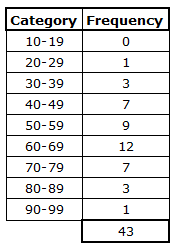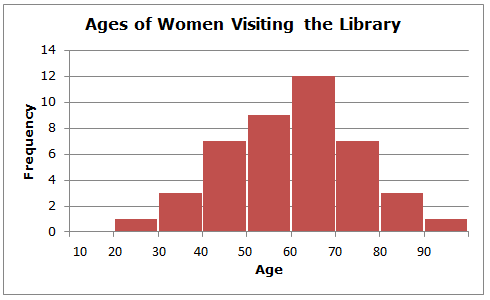Histogram
A histogram is used to give a visual representation of numerical (quantitative) data. Here is a frequency table for the ages of women visiting the library during a wine-and-cheese book-signing event. We will display the data in a histogram.

We can see that there were, for example, 7 women in the age class of 40-49 and 1 woman in the age class of 20-29. The frequency table gives us a good summary of the ages, but trying to take in all of the data at once can be overwhelming. To make visualization of the data easier, we often display the data in a histogram. That is, the histogram gives us a visual picture of the data contained in the frequency table.
A histogram is similar to a bar chart, except that a histogram typically has number ranges (classes) on the horizontal x-axis (for example, ages 10-19, ages 20-29, and ages 30-39), whereas a bar chart typically has categories (for example blue car, red car, yellow car, etc.). Also, the bars on a bar graph do not touch one another, but the bars on a histogram do. On a histogram, the y-axis (vertical scale) is used to display the frequency of each category.
The ages of women who attended the wine-and-cheese book-signing event at our local library produce the following histogram. (Note that the bars are not quite touching, but this is for display purposes so that you can see the individual bars more clearly.)

We easily see that the shape of the histogram is roughly symmetrical and that the center is about age 60. The category with the highest frequency, which is also called the modal class, is the age group 60 - 69, with a frequency of 12. The range of values is about 80.
Note that the horizontal scale (x-axis) of the histogram shows only the lower values of each class (20, 30, 40, etc.). This serves to keep the histogram uncluttered and easier to interpret.
The histogram is a powerful tool for displaying numerical data.

We can see that there were, for example, 7 women in the age class of 40-49 and 1 woman in the age class of 20-29. The frequency table gives us a good summary of the ages, but trying to take in all of the data at once can be overwhelming. To make visualization of the data easier, we often display the data in a histogram. That is, the histogram gives us a visual picture of the data contained in the frequency table.
A histogram is similar to a bar chart, except that a histogram typically has number ranges (classes) on the horizontal x-axis (for example, ages 10-19, ages 20-29, and ages 30-39), whereas a bar chart typically has categories (for example blue car, red car, yellow car, etc.). Also, the bars on a bar graph do not touch one another, but the bars on a histogram do. On a histogram, the y-axis (vertical scale) is used to display the frequency of each category.
The ages of women who attended the wine-and-cheese book-signing event at our local library produce the following histogram. (Note that the bars are not quite touching, but this is for display purposes so that you can see the individual bars more clearly.)

We easily see that the shape of the histogram is roughly symmetrical and that the center is about age 60. The category with the highest frequency, which is also called the modal class, is the age group 60 - 69, with a frequency of 12. The range of values is about 80.
Note that the horizontal scale (x-axis) of the histogram shows only the lower values of each class (20, 30, 40, etc.). This serves to keep the histogram uncluttered and easier to interpret.
The histogram is a powerful tool for displaying numerical data.
|
Related Links: Math Probability and Statistics Pie Chart Stemplot (Stem-and-Leaf Diagram) The Back-To-Back Stemplot Probability Activity with Spinner Independent or Dependent Events Quiz |
To link to this Histogram page, copy the following code to your site:
